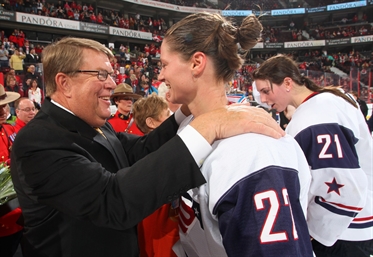Players, USA Hockey move on
Players, USA Hockey move on
“We have to do this together”—Dave Ogrean

 The show continues: USA Hockey executive director Dave Ogrean hands a gold medal to Kacey Bellamy at the 2013 IIHF Ice Hockey Women's World Championship with Hilary Knight on the right. Photo: Andre Ringuette / HHOF-IIHF Images
The show continues: USA Hockey executive director Dave Ogrean hands a gold medal to Kacey Bellamy at the 2013 IIHF Ice Hockey Women's World Championship with Hilary Knight on the right. Photo: Andre Ringuette / HHOF-IIHF Images
There has been chaos and confrontation, anxiety and upset, but as Plymouth, Michigan gets ready for the first games of the 2017 IIHF Ice Hockey Women’s World Championship the game is strong, vital, and ready for its close-up.
“I think what we did was get everyone’s attention and get people talking about women’s hockey outside the Olympics, so this is going to be the biggest Women’s World Championship ever,” said Hilary Knight yesterday after Team USA’s first and only pre-tournament practice.
What did the American women do? They took a stand, threatened to boycott the event at home, and stood up for what they believed in.
What did USA Hockey do? Negotiated, responded, agreed to an historic contract with the national women’s team that makes the game stronger in every way.
“A group of us just complained around the coffee table for many years, and finally we said, no. It’s 2017; we need to be paid,” Knight elaborated. “Fortunately USA Hockey listened, so it’s a successful story and we're ready to go. I think it’s important to note this doesn’t necessarily affect our group; it’s more about the next generation, and I think that’s what made our cause all the more noble.”
“The first initiative 14 months ago,” related Dave Ogrean, USA Hockey’s executive director, “was about the same topics we’ve talked about for much longer, which is a change in how they are treated, financial support, their preference not to have to carry other jobs so they could focus on training and playing hockey, so they could have some certainty about signing a lease or taking on a mortgage, not having so much uncertainty in their lives.”
But the women grew impatient. They weren’t happy with the pace of negotiations, and with the Women’s Worlds on home ice they saw a chance to leverage their position.
“We had a variety of discussions,” Ogrean continued, “but we explained that the typical process for budgetary approval would be through the executive committee meeting at the end of April after which the budget would be ratified by our board in June. We thought we had more time, but they chose—and I fully understand—to accelerate things because we had the World Championship here. And we wanted to have our best players in Plymouth, of course.”
“I’ve been in this program for eleven years and this felt like the first time we actually took a stance,” Knight said. “With the World Championships at home, I’m excited that we were able to do it, have that landmark moment.”
“We get it. Business is business,” Ogrean added. “That doesn’t change friendships and relationships. We move forward, and we have a shared responsibility to grow the sport and generate interest in the sport, and find financial support for the sport. We have to do this together.”
Support for the players the last two weeks, particularly on social media, has been staggering. That support empowered the women but also brought the two sides together in the knowledge that women athletes in general are more deserving of equitable treatment than what history has shown.
“The thing about sports is you have to adjust and adapt,” Knight continued. “We’ve had this ongoing battle for many years now, but USA Hockey is now making a significant contribution to women’s hockey. We show up and play in this amazing tournament, so it’s win-win for everybody.”
Importantly, some of the encouragement during the process, and congratulations at its conclusion, came from Canadian players, arch-rivals on ice but comrades in arms off it. “As much as the rivalry is huge when we get on the ice and it seems that we hate each other, away from the ice we’re in the same circles a lot, so we got a lot of support from those guys, which was super appreciative,” Knight said.
Both players and USA Hockey agreed to keep terms of the four-year agreement confidential, not because it’s a big secret but because pinning down a number is more difficult than it sounds.
“It’s very easy to misconstrue financial information,” Ogrean explained. “For instance, Canadian players get money from Hockey Canada, but also from the Canadian government. Our women get money from the U.S. Olympic Committee and USA Hockey. And how is USA Hockey supported? From the National Hockey League and sponsors. So the women make money from an aggregate of sources. What you read in the papers is mischaracterized and the numbers are amalgamated when they shouldn’t be. There are a lot of elements that make up what a player makes in a given year.”
Back to Overview














































